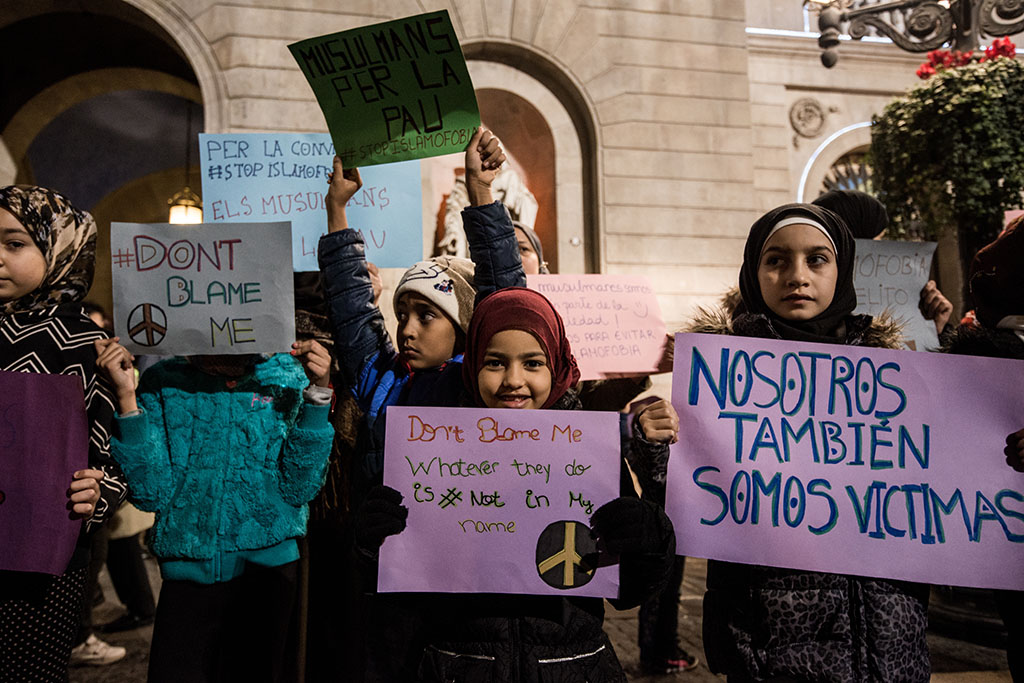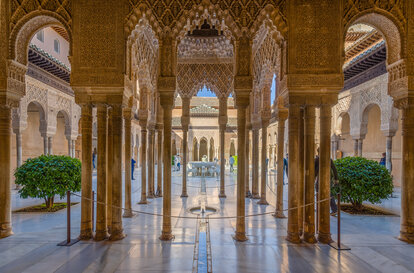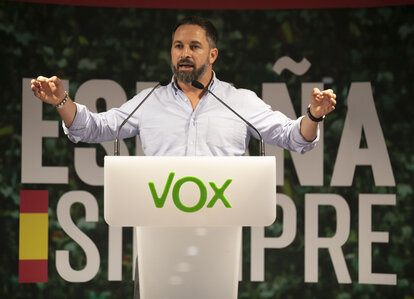Migration & religious pluralism
Migration and religious diversity in Spain

Barcelona protest, 2016 Spain.
© BRAIS G. ROUCOIn the last three decades, migration has undergone drastic changes in its general characteristics, due, firstly, to the multiple push factors in developing countries[1] and, secondly, to the pull factors in developed countries[2]. In addition, there are other factors, such as improved transport and communications in an increasingly interconnected and globalised world.
Today, all countries are involved in the movement of people, either as countries of origin, transit or destination. According to the latest report of the International Organisation for Migration, the number of international migrants worldwide stands at 281 million. Immigrants represent 3.6% of the world's population, and of this total, almost half (49 %) are women.
In the case of Spain, in less than two decades has gone from being a country that expels migrants to becoming a preferred destination country for 6,007,553 citizens from Africa, Latin America, Asia and several Eastern European countries, according to data from the Permanent Immigration Observatory as of 1 January 2022.
This arrival has reconfigured the Spanish religious map and has made Spain a more diverse, more plural country, richer in possibilities, but also more problematic and in need of devising and promoting spaces and policies for coexistence between the different religions and beliefs professed by its more than 47 million inhabitants, both nationals and migrants.
According to the latest barometer carried out in April 2022 by the Spanish Sociological Research Centre, 17.3% of those surveyed declare themselves to be practising Catholics (39.9% identify themselves as non-practising Catholics) and 2.6% as believers in other religions. In addition, 12.4% consider themselves agnostic, while non-believers 11.4% and atheists 14.8%.

Court of the Lions of Alhambra
© Tuxyso - Creative Commons WikipediaThe Episcopal Conference estimates that there are 32.6 million Catholics. The Federation of Evangelical Religious Entities of Spain estimates that there are 1.7 million Protestants, 900,000 of them migrants. The Union of Islamic Communities of Spain estimates that there are 2.3 million Muslims; while the Federation of Jewish Communities of Spain estimates that there are 40,000 Jews. In addition, there are 900,000 Orthodox Christians; 113,000 Jehovah's Witnesses; 85,000 Buddhists and 54,000 Mormons, as well as other religious groups such as Christian Science, Baha'ism (12,000), Scientology (11,000) and Hinduism. Catalonia, Andalusia and Madrid, as well as the autonomous cities of Ceuta and Melilla, have the highest percentage of non-Christians, almost 50% in the latter two.
In the last 15 years, numerous studies have been carried out on most of these religions, especially on Islam, the second most professed religion in Spain. According to Metroscopia's four 'Opinion Barometers of the Muslim Community of immigrant origin in Spain', Muslims of immigrant origin consider themselves adapted to Spanish life: 67% say they feel clearly at ease; 83% consider themselves adapted; 90% have a broad and plural relational environment; 5% have married Spaniards in recent years and a clear majority consider that marriages between Muslims and Christians should be accepted as a matter of course. As for their fluency in Spanish, the vast majority say they have a reasonable knowledge of the language and, among those who live on the Mediterranean coast, one third say they know Catalan or Valencian.
In contrast to this positive image of Muslims of migrant origin in Spain, more than 50% of Spaniards have a negative image of them and 70% think that they are the religious group that creates the most problems in the world, which hinders their desired integration.

Act of Santi Abascal with affiliates and supporters of Vox in the Extremadura town of Cáceres, 2019.
© flickrMost of the studies carried out since 2010 warn about the growth of Islamophobia indicators. According to the University Institute for Migration Studies at Comillas Pontifical University, since the beginning of the economic crisis in 2008, there has been an annual average of 12,000 discriminations and hate crimes against people or groups stigmatised as Muslims, migrants or migrants with Arab physical features. Many mosques and shops owned by migrants of Moroccan origin have received racist attacks and threats.
This slippage of public opinion towards positions unfavourable to religious and cultural diversity has intensified in recent years, following the emergence of Vox in the Andalusian Parliament in 2018, and in the Congress of Deputies and several town councils in 2019. The latest reports by SOS Racismo and the Platform Against Islamophobia show that Vox's discourse in the last five years has permeated a large part of society.
According to the latest 'Annual report on Islamophobia in Spain', there is a growing Islamophobic bias among political leaders of different ideologies; a very active role of the extreme right and neo-Nazi groups, with attacks on mosques from time to time; an increase in gender Islamophobia, with attacks on Muslim women; and school, work and/or social discrimination because of hijab. On the other hand, cyber-hate accounts for 70% of the incidents reported in the report. The proliferation of Islamophobic messages on the Internet and social networks, taking advantage of the ignorance and vulnerability of the cyber community, dehumanises, alienates and defames Muslims, Islam and refugees.
In view of the above, this religious diversity and cultural plurality needs to be well managed, adopting political and legislative measures to promote coexistence and interreligious and intercultural dialogue, eradicating discrimination and hate crimes.
To this end, it is necessary to promote educational and civic measures to inform and raise awareness of the positive aspects of religious diversity and cultural plurality, and to invest in education, in accordance with the recommendations of Unesco, the OSCE and other European institutions such as the Agency for Fundamental Rights.
[1] Such as: the high birth rate growth, lack of employment, economic instability, increasing poverty, costs related to some conflicts or civil wars, corruption, wage differentials, poor income distribution between developed and developing countries, low contributions from developed countries as Official Development Assistance (ODA), and environmental degradation.
[2] Among which the following stand out: the economic strength of these countries, the ageing and low birth rate, the lack of labour in some sectors of activity, the geographical proximity (in the case of some Western and Central European countries to non-EU countries in the south and east of the Mediterranean and the USA with 2,250,486 Mexico and some Caribbean countries), the impact of the audiovisual and telecommunications sector (satellite television and Internet).
